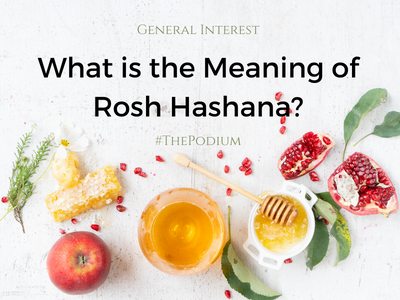
By Jessica Melton
Every September, people of the Jewish faith celebrate Rosh Hashanah. But what exactly is that holiday and what does it mean? I’m glad you asked! Rosh Hashanah is the Jewish New Year and is the start of the High Holidays or High Holy Days. The ending of the High Holy Days is with Yom Kippur (the day of atonement). This year, Rosh Hashanah begins on the first (or sometimes second day) of Tishrei in the year 5783 according to the Jewish calendar. In English, Tishrei means “the first month in the Jewish New Year” which follows the lunar cycle.
So, what happens on Rosh Hashanah? On the eve of Rosh Hashanah (the first of the two-day celebration), Jewish people go to Temple to welcome in the New Year. A service is held to close out the former year and start the new one. The evening service typically does not include the blowing of the Shofar (or rams’ horn). In most Temple that is saved for the morning service for the next day. However, it can vary from each Temple or sector of Judaism. The blowing of the Shofar represents the trumpet blast that is sounded at a king’s coronation. Its plaintive cry also serves as a call to repentance. The shofar itself recalls the “Binding of Isaac”, an event that occurred on Rosh Hashanah in which a ram took Isaac’s place as an offering God.
Next, after the morning service is finished, apples and honey are served. This is to represent a “sweet new year”. It is said that when you eat the apples and honey, then you will have a prosperous and sweet new year.
Finally, after sitting through services, Tashlich pronounced (tash-leek) is observed by going down to a riverbank to cast your sins. There are several reasons that this custom is observed:
- One reason for saying Tashlich next to water goes back to Abraham’s trip to sacrifice his son, Isaac, which took place on Rosh Hashanah. On the way to the designated location, Satan tried several times to undermine Abraham’s progress. One of Satan’s tricks was to have a river materialize and block Abraham’s path. Undeterred, Abraham forged on straight into the river followed by his small entourage. Upon reaching the middle of the river when the water reached his neck, Abraham prayed to God and the river dried up. We commemorate the self-sacrifice of Abraham by going to a river bank.
- Going to a river bank or sea shore is also awe-inspiring as we contemplate God’s mercy in preventing the waters from flooding the dry land. The realization of God’s omnipotence inspires us to repent.
Though we do Tashlich beside an earthly river or sea, this watery entity actually represents its Heavenly counterpart. Jewish mysticism teaches that water corresponds to the attribute of kindness. On Rosh Hashanah, we beseech God to treat us with kindness during the new year. - Water with fish is optimal since fish are not subject to the “evil eye” and are also known to have many offspring. Fish do not have eyelids, so their eyes are always open. This is likened to God’s constant supervision over us, and we pray that He mercifully cares for us. Also, just as fish may be caught in a fisherman’s net, so, too, we are caught in the net of judgment. This awareness helps awaken us to repent.
Though it sounds like a lot to do, these services mean a lot to a person of Jewish faith. I hope this blog answered some questions about what Rosh Hashanah means. For more information, please go to the Chabad webpage Here
Categorized in: General
| << previous | next >> |








